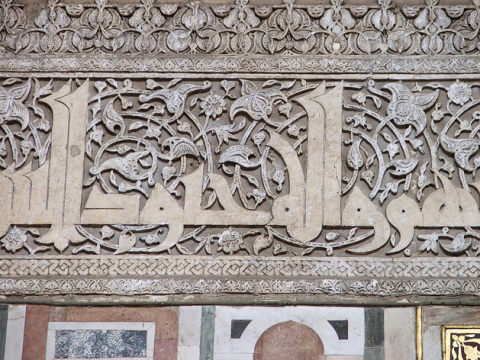What Is One Similarity Between Early Christian and Early Islamic Art

Christ, Monastery of Saint Catherine at Mount Sinai, sixth century
I just finished a very busy, busy quarter. One of the classroom discussions that I will think most involved a comparing between Islamic imagery and Christian imagery. Earlier discussing Islamic imagery, I introduced my students to Byzantine icons. We discussed how the frontal orientation of figures and direct eye contact were essential in the icon tradition, since such compositional devices encourage interaction with the viewer.ane In the case of the icon of Christ from the Monastery of Saint Catherine (one of the few icons which escaped devastation during the menstruum of iconoclasm in the 8th and ninth centuries), we too discussed how the composition of Christ's face was significant: "The right side of Christ's face up (our left) is open, receptive and welcoming, whereas his left side – Byzantium's tradition side of judgment and condemnation – is harsh and threatening, the eyebrow arched, the cheekbone accentuated past shadow, and the mouth drawn down as if in a sneer."2
To continue this discussion, I emphasized to my students that in many ways figural imagery lends itself to Christianity: Christ causeless a human being trunk ("the Word became flesh") and Christians are supposed to emulate the actions of Christ. Christians are also encouraged to emulate the lives of virtuous individuals, such every bit saints and martyrs. Such emulation and mimicry is encouraged when in that location is figural imagery, perhaps especially when such imagery exists in a narrative scene.
To emphasize this point well-nigh mimetic beliefs, I had my students read a brusk article by Gary Vikan on Byzantine icons: "Sacred Image, Sacred Power." I really like Vikan's discussion of images and imitative behavior, which he supports with a ivth century quote from St. Basil. Basil explains how there is a parallel between the workshop practise of artists and the appropriate behavior of Christians:
"…just equally painters in working from models constantly gaze at their exemplar and thus strive to transfer the expression of the original to their artistry, and then likewise he who is anxious to make himself perfect in all the kinds of virtue must gaze upon the lives of saints as upon statues, so to speak, that movement and act, and must make their excellence his own by faux." 3
January Steen, "The Dissolute Household," ca. 1663-64
Although there were periods of iconoclasm in Christian history, I believe that the mimetic behavior of Christians is one of the reasons that figural imagery generally has prevailed in Christian art. And fifty-fifty during some of the comparatively subsequently periods of iconoclasm, such every bit that experienced past Protestants, the secular imagery at the time was however based on mimetic beliefs – particularly the moralizing themes found in Northern Renaissance and Northern Baroque art. Even when Christians weren't looking toward strictly religious subject matter, they even so looked toward paintings to help enforce what behavior they should mimic or avoid. Such moralizing paintings were created past Jan Steen, including The Dissolute Household (ca. 1663-64, encounter above).

Dome of the Rock, 687-91 CE, Jerusalem. Epitome courtesy Wikipedia
In dissimilarity with Christianity, Islam doesn't have exactly the same blazon of foundation in mimetic beliefs: God revealed himself to Mohammad through his discussion, and therefore the words of the Qu'ran have precedence in religious imagery.4 For Islam, words are the embodiment of God. This point was emphasized in an article that I shared with my students, "The Prototype of the Word" past Erica Cruikshank Dodd. She explains, "The written or the recited Koran is thus identical in beingness and in reality with the uncreated and eternal word of God. . . If God did not reveal Himself or His Epitome to the Prophet, he nevertheless revealed a faithful 'moving picture' of his word."5 God sent downwardly his image in the form of a book. In turn, Muslims decorate the interior and/or exterior of their religious spaces with phrases from the Qu'ran, every bit tin be seen on the outside of the Dome of the Stone (a structure that Oleg Grabar describes as a "very talkative building").

Floriated kufic script at the Sultan Hassan Mosque-Madrassa in Cairo, later on 1356 CE
Despite the central differences in Islamic art and Christian fine art, it is fun to discover some visual similarities. I like to consider how the words of the Qu'ran, as depicted in apartment, two-dimensional text, have parallels with the flat stylizations plant in many Byzantine icons. In some cases, every bit seen in the kufic script above, the elongation of the script has an interesting parallel with the elongation of human figures in Byzantine art. Furthermore, both text and image limit the altitude betwixt the viewer and representation past rejecting three-dimensional illusionism. Every bit a result, the devout viewer is able to become every bit close to the embodiment of God as possible, whether that be an image or text.
1 Other visual devices in icons which encourage interaction with the viewer include the gold groundwork (which removes the distraction of earthly or "real" time), half-length figures (to push the figure closer to the viewer), and overly-large eyes.
two Gary Vikan, "Sacred Paradigm, Sacred Power," in Tardily Antiquarian and Medieval Art of the Mediterranean Earth by Eva R. Hoffman, ed. (Malden, MA: Blackwell Publishing, 2007), 137.
3 Ibid., 140.
iv Although Muslims strive to maintain lifestyle outlined and adept past the Prophet Muhammad, as explained in the Sunnah, the writings of the Qu'ran are the master source for the Islamic faith and its religious fine art.
5 Erica Cruikshank Dodd, "The Epitome of the Give-and-take," in Late Antiquarian and Medieval Art of the Mediterranean World by Eva R. Hoffman, ed. (Malden, MA: Blackwell Publishing, 2007), 193.
Source: http://albertis-window.com/2013/03/christian-and-islamic-art-flesh-vs-word/
0 Response to "What Is One Similarity Between Early Christian and Early Islamic Art"
Enviar um comentário